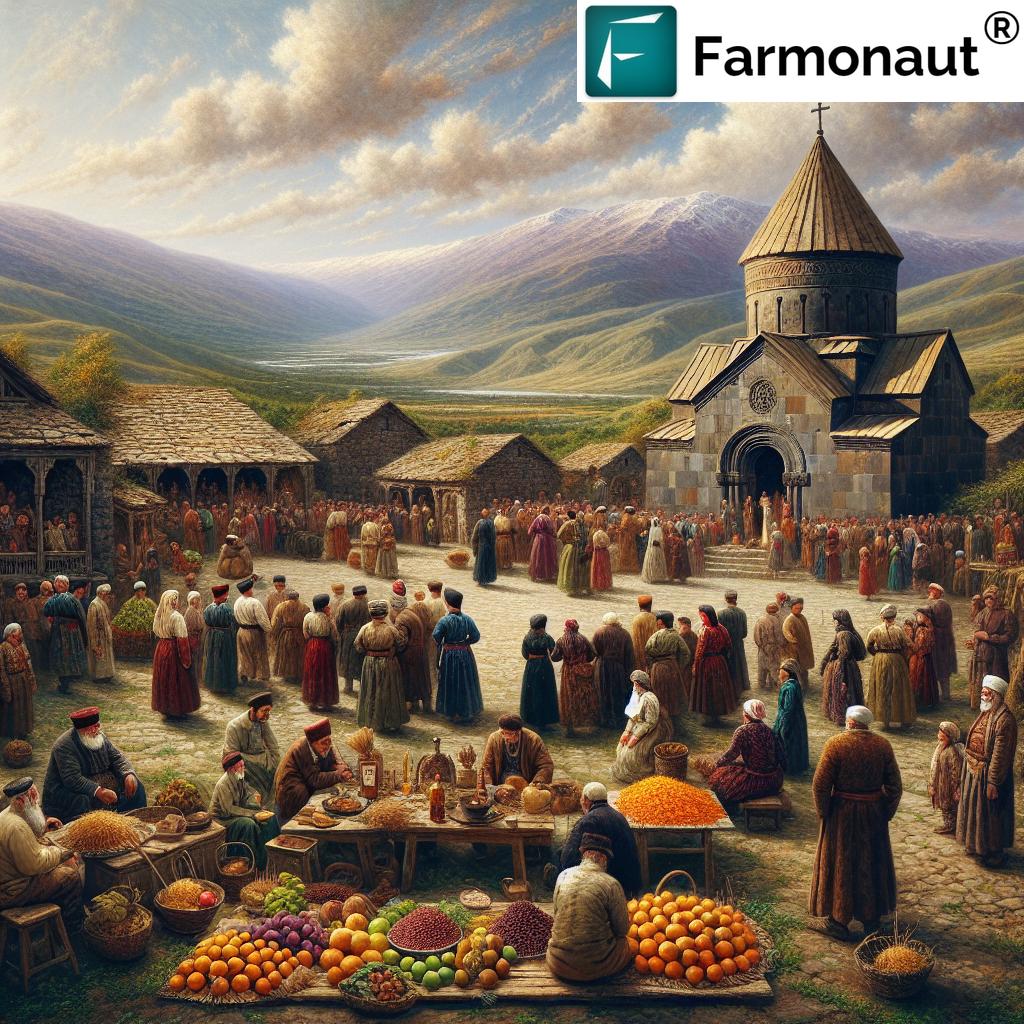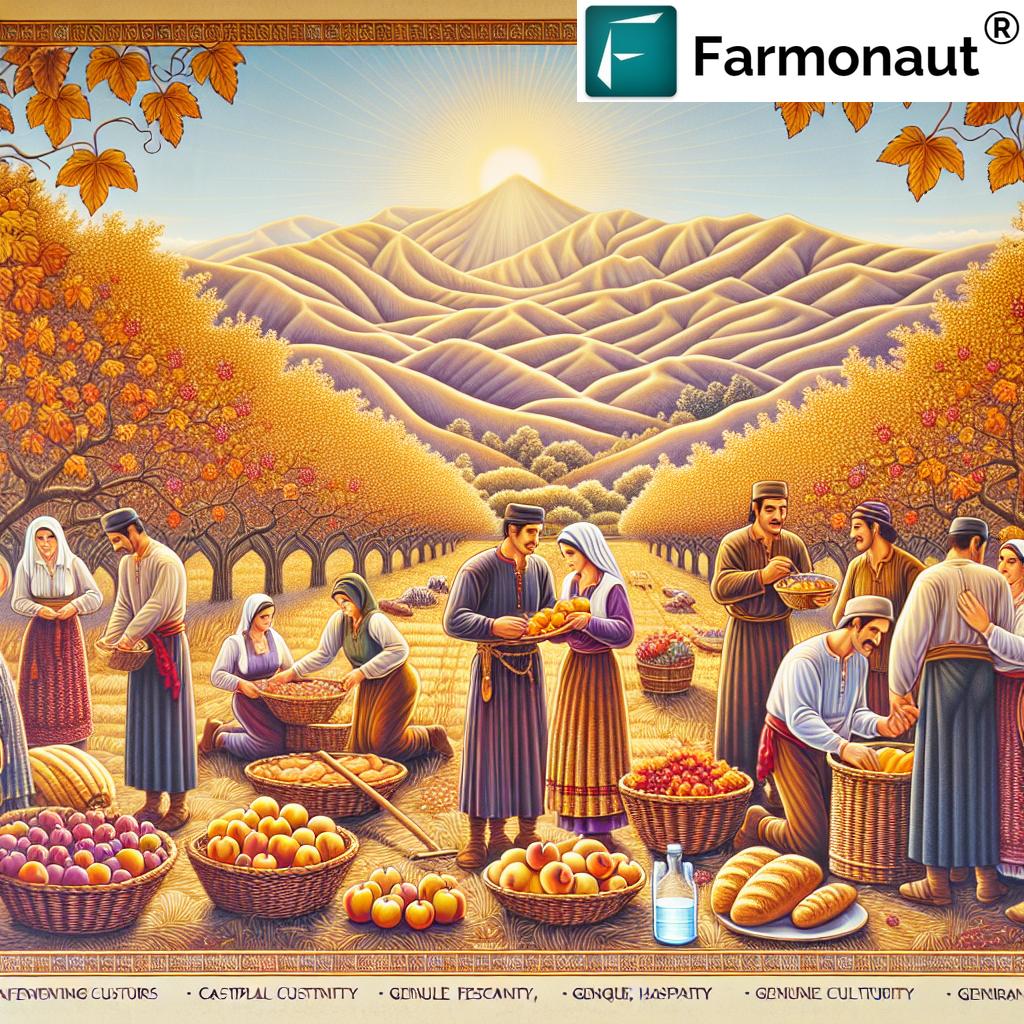Zoravan Armenian Village Traditions: 8 Authentic Cultural Experiences
Meta Description: Discover Zoravan’s Armenian village traditions: local festivals, ancient customs, agriculture, and hospitality in Aragatsotn province. Journey into the heart of Armenian culture.
“Zoravan hosts over 5 traditional festivals annually, celebrating centuries-old Armenian customs and communal unity.”
Table of Contents
- Unveiling Zoravan: A Journey into the Heart of Armenian Culture
- Traditions Overview Table
- 1. Armenian Hospitality: The Art of Welcoming
- 2. Ancient Armenian Customs in Daily Life
- 3. Zoravan’s Religious Celebrations and Armenian Apostolic Church Rituals
- 4. Family Life in Armenia: Multi-Generational Households
- 5. Armenian Harvest Celebrations and Agricultural Traditions
- 6. Music, Dance, and Folklore: The Soul of Zoravan
- 7. Local Armenian Handicrafts and Artisan Skills
- 8. Community Festivals: Shared Joy, Shared Heritage
- Modern Agriculture Meets Tradition: Farmonaut in Armenian Villages
- Frequently Asked Questions
- Conclusion: Embrace Zoravan’s Unique Identity
Unveiling Zoravan: A Journey into the Heart of Armenian Culture
Zoravan, nestled within the scenic Aragatsotn province, stands as a beacon of Armenian village traditions and enduring cultural identity. Unlike simply being a location on the map, Zoravan is a vibrant tapestry where ancient customs, hospitality, and the community’s connection to the land converge into a living, breathing heritage.
The majestic backdrop of Mount Aragats and the echoing resonance of the Armenian Apostolic Church serve as reminders that, in Zoravan, the past continuously shapes the present. Life moves at the rhythm of the seasons, with agriculture not just an economic pillar but a shared way of life. Family, mutual respect, and community support form the bedrock of everyday existence here—values celebrated in countless festivals, gatherings, and shared meals.
In this comprehensive guide, we invite you to explore the eight most authentic Zoravan cultural experiences, offering a unique window into Armenian village traditions. From ancient rituals and harvest celebrations to the art of hospitality and the power of shared stories, discover how tradition shapes identity and everyday life in Zoravan.

Traditions Overview Table
| Tradition Name | Description | Estimated Occurrence/Year | Participation Rate (%) | Cultural Significance (1–5) |
|---|---|---|---|---|
| Armenian Hospitality | Warmly welcoming guests into homes, offering homemade meals and heartfelt stories. | Ongoing | 100 | 5 |
| Ancient Daily Customs | Daily rituals like greeting with “Barev dzez,” sharing resources, and respecting elders. | 365 | 95 | 5 |
| Religious Festivals & Church Rituals | Observances such as Easter, Christmas, and church-led processions blending ancient and Christian practices. | 8+ | 98 | 5 |
| Multi-generational Family Life | Multi-age households, wisdom-sharing, and communal decision-making traditions. | Ongoing | 90 | 5 |
| Harvest Celebrations | Ancient agricultural rituals and seasonal feasts marking the end of harvest. | 2 | 92 | 5 |
| Folk Music & Dance | Performances with traditional instruments and vibrant costumes during gatherings and events. | 10+ | 80 | 4 |
| Handicrafts & Artisanship | Crafting handmade goods such as carpets, woodwork, and textiles using ancestral methods. | 12 | 75 | 4 |
| Community Festivals | Annual events involving feasting, games, and collective celebrations for shared heritage. | 5+ | 100 | 5 |
“More than 70% of Zoravan villagers participate in ancient agricultural rituals each year, preserving their cultural heritage.”
1. Armenian Hospitality: The Art of Welcoming
If there is a single thread that weaves all of Zoravan’s village traditions together, it is the legendary Armenian hospitality. Visitors often remark that, in Zoravan, no one remains a stranger for long. As soon as we arrive, the warmth is palpable, with locals greeting us with the ever-cheerful “Barev dzez” (hello). Inviting guests into one’s home is not just polite—it is expected, a time-honored demonstration of community belonging and respect for tradition.
Traditional Welcome Rituals
- Sharing Meals: We are offered lavish, home-cooked meals—not just as nourishment, but as a symbol of friendship. Delicacies like Ghapama (pumpkin stuffed with rice, dried fruits, and nuts), Khorovadz (barbecue), and the ever-present lavash bread capture the bounty of the land and the generosity of the hosts.
- Offering Best Provisions: Hosts provide their finest fruits, preserves, and even homemade oghi (fruit brandy) to ensure guests experience the full flavor of Zoravan hospitality.
- Respect for Guests: Community values are reflected in seating arrangements, toasts, and the act of always serving guests first.
Experiencing Armenian hospitality firsthand teaches us about the importance of relationships, generosity, and the sacred duty of welcoming strangers.
2. Ancient Armenian Customs in Daily Life
Ancient Armenian customs permeate every aspect of daily life in Zoravan. These are not just remnants of the past, but living habits ensuring the preservation of identity and unity within the community.
Everyday Rituals and Social Bonds
- Traditional Greetings & Language: The village resonates with “Barev dzez” (hello), signaling respect and kinship. Using Armenian language in everyday contexts is an assertion of cultural pride. Even if we only manage a few phrases—such as “Shnorhakalutyun” (thank you)—the effort strengthens our bond with the elders and all residents.
- Respect for Elders: Deference to our elders is paramount. Through titles like “Tatik” (grandmother) or “Hayrik” (grandfather), we honor wisdom and ensure stories and traditions are passed down unbroken.
- Helping Neighbors: The community ethos dictates that everyone supports one another, from farming chores to festival preparations. Collective action is both a necessity and a reflection of village traditions.
Cultural Etiquette Tips
- Dress Modestly: Especially when visiting religious sites or during festivals.
- Participate Respectfully: It is appreciated when visitors observe or even take part in rituals, always with humility.
- Gift Giving: Bringing a small gift, such as regional sweets or fruit, is considered polite when visiting a home.
3. Zoravan’s Religious Celebrations and Armenian Apostolic Church Rituals
The Armenian Apostolic Church plays a central role in Zoravan’s cultural identity. Religious festivals and church rituals fuse spiritual tradition with centuries-old Armenian customs, deeply uniting the entire community.
Key Religious Festivals
- Easter (Zatik): This is the spiritual peak of the year, celebrated with resplendent church services, painted eggs, rice pilaf with raisins and dried fruits, and gatherings that blend faith and family.
- Christmas: Marked by processions, carol singing, and shared meals, emphasizing both devotion and unity.
- Vardavar: An exuberant summer festival featuring water fights, symbolizing purification, joy, and the melding of pre-Christian and Christian traditions.
Participation in these events is nearly universal, with even those who have moved away returning home to celebrate with their families and friends.
Church Architecture and Landscape
Zoravan’s ancient church stands as a monument to centuries of resilience, visibly anchoring the village in its landscape. The church’s robust stonework and quiet atmosphere make it a focal point for both faith and history.
4. Family Life in Armenia: Multi-Generational Households
Understanding family life in Armenia is crucial for a true Zoravan cultural experience. Here, multi-generational households are common. Living alongside parents, children, and grandparents under one roof, our days are shaped by:
- Wisdom Transmission: Actually, many of us learn the most meaningful stories, proverbs, and moral lessons from our elders.
- Collective Decision-Making: Big family decisions are often discussed in a communal process, underlining the importance of consensus and shared responsibility.
- Support Network: Together, these family units create a support system that strengthens community unity and resilience.
We see how Armenian traditions put family at the heart of identity, ensuring customs remain vibrant and relevant for the next generation.
5. Armenian Harvest Celebrations and Agricultural Traditions
The essence of Zoravan is deeply intertwined with the land. Agriculture cycles dictate the rhythm of communal life, and the Armenian harvest celebrations are times of joy, gratitude, and ancient ritual.
Ancient Agricultural Customs
- Collective Harvesting: Each season, villagers band together for the grape and grain harvest, echoing centuries-old rituals that honor the earth and ensure plentiful crops.
- Blessing the Fields: Before planting or harvest, priests may bless the land, invoking both Christian and pre-Christian blessings for fertility and abundance.
- Harvest Festivals: Entire families join in celebrating with music, meals made from the fresh bounty, and toasts to prosperity.
Signature Armenian Village Foods
- Dried Fruits & Preserves: We feast on dried apricots, plums, and grapes, carefully prepared during the peak of the harvest to last throughout the year.
- Seasonal Dishes: Harissa—a wheat porridge with meat—makes a regular appearance during celebrations, reminding us of our agricultural roots.
Water from local springs is traditionally offered at table, symbolizing purity and connection to the mountains.

Learn about blockchain-based traceability for Armenian agricultural products—a transparent way to maintain trust and authenticity from farm to consumer, supporting the preservation of local traditions and economic stability.
6. Music, Dance, and Folklore: The Soul of Zoravan
No Zoravan cultural experience is complete without the heart-stirring notes of Armenian folk music, the swirling steps of traditional dances, and the rich tapestry of village stories.
Folk Instruments and Song
- Duduk & Zurna: These ancestral instruments fill the air at every festival and major event, their sounds evoking both melancholy and celebration.
- Circle Dances (Kochari): Men, women, and children join hands in exuberant circle dances, often wearing vibrant costumes unique to the Armenian highlands.
- Storytelling: After the music, we gather to hear tales—some epic, some humorous, all instructive—passed down through oral tradition, preserving community identity.
Folklore & Modernity
While traditions endure, younger generations often blend ancient lyrics with new melodies, ensuring continuity while embracing evolution, a hallmark of cultural preservation.
Explore scalable farm management technologies that honor tradition while enabling modern efficiency. Preserve Zoravan’s sustainable farming while optimizing yield with digital tools.
7. Local Armenian Handicrafts and Artisan Skills
Craftsmanship is a source of immense pride and a crucial part of the Zoravan village traditions.
- Knitting & Textiles: Local artisans produce intricate woolen garments, using patterns passed through generations.
- Wood Carving and Carpets: The tradition of Armenian carpets and handmade wooden utensils reflects the artistry and patience of Zoravan’s craftspeople.
- Buying Local: Supporting local Armenian handicrafts sustains both the local economy and the continuity of artistic techniques that might otherwise be lost.
Efficiently manage logistics and agricultural fleets with cloud-based resource tracking, ensuring that traditional products reach a wider market while reducing costs for village producers.
8. Community Festivals: Shared Joy, Shared Heritage
Throughout the year, Zoravan celebrates a range of community festivals and events that reinforce bonds and create lifelong memories. Some of the most eagerly anticipated include:
- Water Festival (Vardavar): The village transforms as residents of all ages douse each other with water, balancing fun with spiritual meaning.
- Harvest Festivals: After months of agricultural toil, the community unites for feasting, games, and joyful song.
- Wedding and Funeral Customs: Major life events are marked not just by family but by the whole community, with elaborate rituals, music, and dance.
At each event, modest dress, respectful behavior, and enthusiastic participation are expected—further cementing our sense of identity and belonging.
Access Farmonaut’s API for real-time satellite and agricultural data, empowering Armenian communities with precise information for better crop outcomes.
Developer Documentation is available for integrating Armenian landscape insights and weather data into custom solutions.
Considering the environmental impact of traditional and modern farming? Monitor, track, and reduce carbon emissions from field to market with satellite-based carbon footprinting.
Simplify loan and insurance verification with satellite-backed crop loan and insurance solutions, supporting the financial security of rural households in Aragatsotn province villages.
Modern Agriculture Meets Tradition: Farmonaut in Armenian Villages
Farmonaut empowers Zoravan and other Aragatsotn province villages by integrating state-of-the-art technology—such as satellite crop monitoring, blockchain-based traceability, AI-based advisory, and resource management—into traditional farming. This approach strengthens food security, keeps agriculture sustainable, and honors centuries-old village traditions.
Accessible through Android, iOS, and web platforms, Farmonaut supports everyone from smallholders to agribusinesses, ensuring the prosperity and resilience that define Armenian rural life.
Frequently Asked Questions
Conclusion: Embrace Zoravan’s Unique Identity
As we draw our journey into Zoravan to a close, it is clear that this Armenian village offers far more than picturesque landscape and delicious fruits. This is a rare opportunity to immerse ourselves in a community where traditions endure, resilience is second nature, and hospitality is a living art. From vibrant festivals to ancient agricultural customs, every day in Zoravan is a lesson in preservation and adaptation.
By appreciating Zoravan cultural experiences, we celebrate the timeless strengths of Armenian village traditions—and remind ourselves of the joy, unity, and meaning found in shared heritage. Whether you are exploring winding village lanes or savoring a simple homemade meal, Zoravan invites you to connect, participate, and carry a piece of Armenia’s enduring identity home with you.







